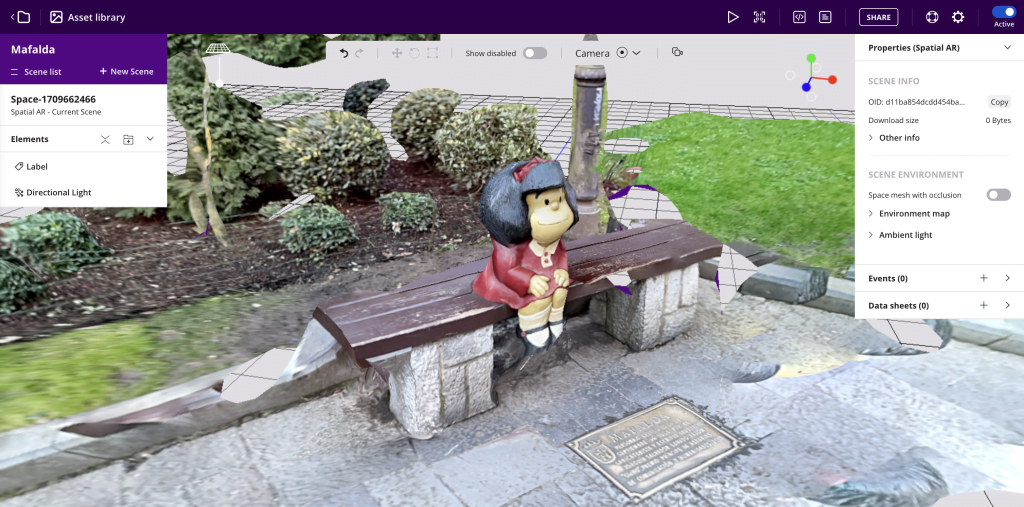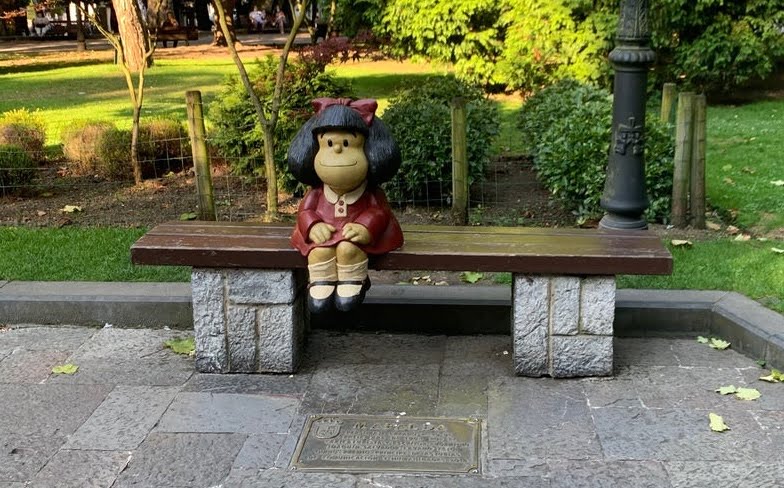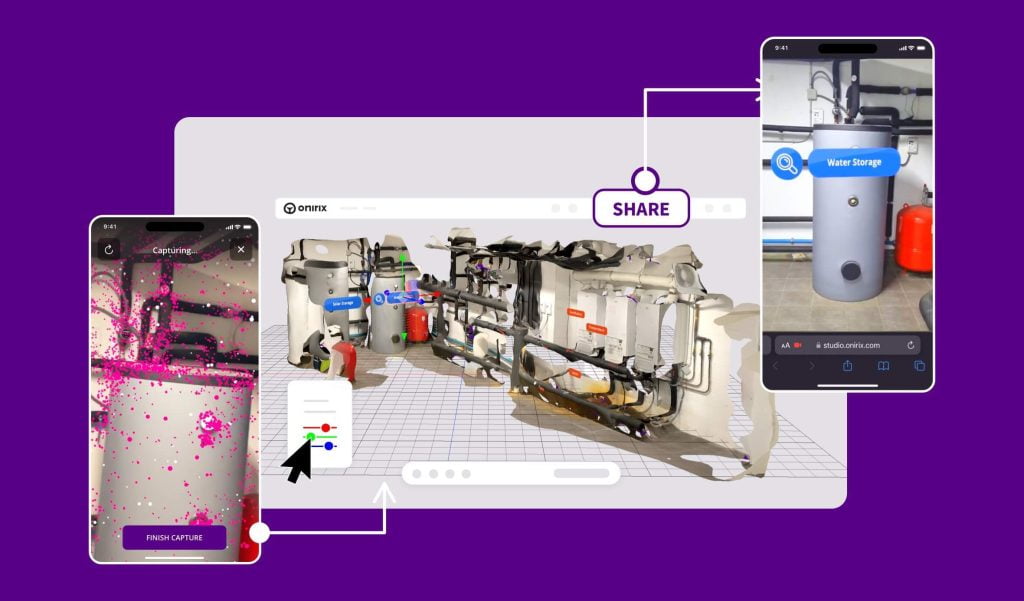Spatial AR: Augmented Reality with Space Recognition without Apps
Contents
We announce the full release of Onirix Spatial AR.
Spatial AR ceases to be a beta to become the only Visual Positioning System (VPS) on the market to offer an instant experience (without downloading Apps) and with total accuracy, both on Android (AR Core) and iOS (AR Kit) devices.
What is Spatial AR?
Spatial AR is a VPS that allows you to scan indoor and outdoor spaces with a smartphone, accurately position augmented reality (AR) content on them and keep it anchored throughout the user experience.
In the following video you can see what I mean.
What is Spatial AR for?
Onirix Spatial AR (Spatial Tracking) recognizes the real environment in much more detail than experiences based on other types of tracking.
For example, surface tracking (World Tracking/SLAM) allows you to place an AR scene in any environment, be it your living room or a factory hallway. Therefore, it lacks intelligence in the analysis of these surfaces: the experience is the same in one place or another.
On the other hand, marker-based tracking (Image Tracking) does recognize a given environment but because it starts from a flat (2D) photograph, it lacks an understanding of depth.
That is why Spatial AR becomes the most complete technology when you want to add information in AR in a given environment, allowing to make a very detailed 3D scan of a static object or complete location and then superimpose virtual content (models, 3D, audio, video, etc) to the real scene.
This content can be enriched through Artificial Intelligence (AI). For example, so that an operator can see real-time data from a machine. Or so that the training on occupational risk prevention carried out in a certain room is updated according to the employee’s progress.
Spatial AR for Industry
Onirix started selling Spatial AR in 2020 to companies in the Industrial sector that were looking for precision tracking of their augmented reality experiences.
These companies were using AR to improve the training and productivity of their workforce by anchoring instructions, steps to follow or sensor information (IoT) in real time. We are talking about companies such as KPMG, Red Eléctrica or Unilever.
However, back then an application was necessary to be able to consume this type of experience. Not anymore.
Spatial AR for Culture
Onirix Spatial AR has eliminated the barrier of having to download an app, leading to a greater demand and fit in other sectors where the goal is to reach a wider audience to scale the impact generated by this type of experiences.
This is the case of the Museo de Cera of Madrid, which opted for Onirix Spatial AR when it was still in its beta version. You can watch their promotional video of the “Dale cera” campaign to get an idea of the project.
Before Spatial AR existed, if, for example, you wanted to include in AR information about a work of art in a museum, you could use the image of that work as a marker so that when you recognized it, the AR experience would begin.
What was the limitation? Each artwork would have to have its own augmented reality experience in isolation. In addition, the image was in two dimensions, making it more complicated to add objects at different depths.
However, with this new technology it is now possible to guide visitors through a space in a particular order, indicate the location of the next experience, include information in AR about the location itself without the context of other elements, etc.
Another use case is the reconstruction of monuments or works of art. The following video shows the success case of the NowAR agency, which used Onirix Image Tracking technology to reconstruct the paintings inside the Ermita de Villacans, in Barcelona.
If they have managed to do this using images to launch the AR experience… Imagine what can be achieved using directly the real environment thanks to Spatial AR.
Spatial AR for Tourism
Other use cases for this technology are: making AR-enriched audio guides, treasure hunts in cities, and making the viewing of a simple statue an immersive and enriching experience for users.
What if you use elements of your city as a medium to create augmented reality experiences that are useful for tourists?
Many tourists travel by public transport such as trains and planes. Any medium is good to impact your target audience.
Spatial AR for Retail
Spatial AR allows you to enrich the user experience at the point of sale through gamification, the inclusion of additional information about offers or availability of items both in-store and in your ecommerce, or even integrating Artificial Intelligence to improve the recommendations made to the user according to their preferences.
If we focus on the point of sale, here are a couple of use cases to inspire you.
Spatial AR for Marketing and Advertising
Augmented reality in the marketing world has been widely used to generate the wow effect. In fact, it has been a trend in recent months for well-known brands to use post-production to fake AR experiences on monuments and city exteriors. This is known as FOOH (Fake Out Of Home).
But why not make Real OOH (Real Out Of Home) to generate a greater impact?
Spatial AR makes it possible to make the fake productions that some brands have accustomed us to a reality. Thus, brands can go a step further and not limit themselves to just sharing FOOH on their social networks, they can also make the users themselves, massively, live in first person these augmented reality experiences.
In the following example you can see a use case.
Spatial AR for HR
It’s a fact that more realistic training generates higher levels of learning. According to a report by Deloitte Insights, augmented reality can improve information retention by up to 80% compared to traditional training methods.
Many of our clients, such as KPMG, Eulen, Preven Control and CEPSA, have contracted us through their HR department to create experiences that facilitate understanding and memorization of content thanks to augmented reality. Also for the prevention of occupational hazards.
To reduce occupational risks thanks to Spatial AR, two ways can be used. The first is by using real-time visual warnings.
The other option is training with simulations in real environments. For example, do you want an employee to learn how to use the fire extinguisher in case of fire? Create an AR experience where the employee can live the experience in their work environment as if it were real, but without taking any risk.
What differentiates Onirix Spatial AR from other VPS?
Onirix’s Spatial AR technology democratizes the use of augmented reality for both the creators and consumers of augmented reality experiences.
Spatial AR democratization for creators
All you need is an iPhone to scan any real-world environment, indoors or outdoors. The AR experience can be consumed from both Android and iOS devices, but at the moment, scanning can only be done from an iPhone.
The mesh of that scan is uploaded directly to Onirix Studio, where you can overlay on top of the AR elements you need without any programming skills.


You can appreciate the quality of the above scan by comparing it with the following photograph of the actual scenario.


Democratizing Spatial AR for consumers
There are 3 major barriers a user encounters when consuming an AR experience and Onirix Spatial AR has removed them all.
Web AR
The end user does not have to download an app to consume experiences created with Onirix Spatial AR, they can do so directly from their mobile browser.
Improved iOS tracking
One of the biggest challenges for Web AR tools is providing users with accurate and stable tracking.
Since Android supports WebXR, allowing tools like Onirix to access the operating system’s capabilities through ARCore, tracking quality is guaranteed on Android devices. But iOS does not yet support WebXR.
However, thanks to Onirix Clip, users with an iPhone will also be able to enjoy instant augmented reality with perfect tracking.
Location areas
It is important that the end user, who will consume the Spatial AR experience, knows how to locate themselves to start consuming a spatial-like experience. To this end, we have created the location areas, which give clear visual guidance clues about the different zones in which a user can locate themselves and start consuming the experience.
Our Chief Product Officer, Carlos Gonzalez, explains this functionality in this video about the v.2.65.0 release. You can directly access the documentation in Docs.
How does Spatial AR work?
In the following image you can clearly see the 3 steps of which this technology is composed:


- Scanning the space or space mapping with Onirix Constructor.
- Scene configuration in Onirix Studio.
- Consumption of the augmented reality experience with a mobile device or headset without the need to download an app.
In Docs you can see the details of the whole Spatial AR process.
Want to try Spatial AR? Register with Onirix for free and click on “Request access to Spatial AR.




